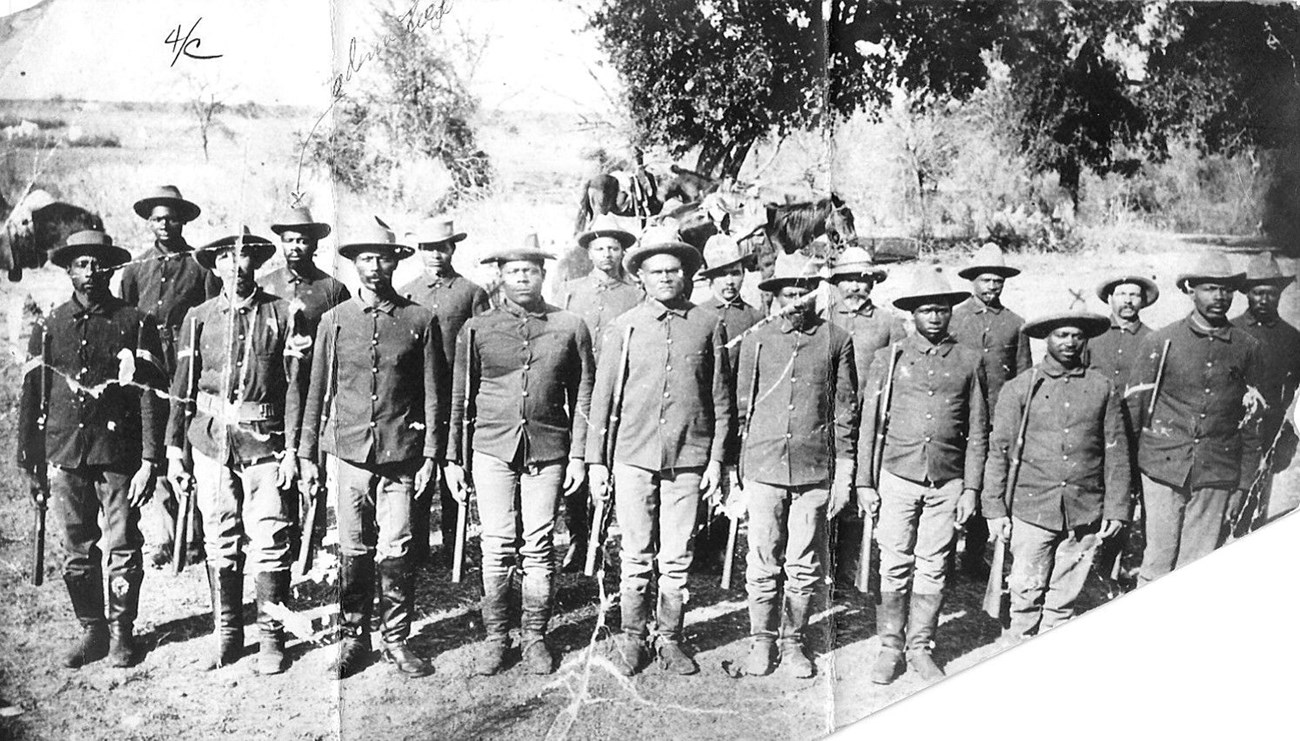Last updated: March 29, 2024
Article
Black Seminole Indian Scouts

Public Domain
The Black Seminole Indians followed a circuitous and difficult path from the swamps of Florida to the borderlands of Texas and Mexico. In the Antebellum South, enslaved people in Georgia and South Carolina self-emancipated south into Spanish-held Florida. The Spanish would not send the now-freed Blacks back to enslavement in the colonies. The freedmen and women would make their way into the hinterland of Florida and encounter the Seminole people, who welcomed them. The newly freed men and women assimilated into Seminole life. The historical record shows that the Black Seminoles lived in their own towns and fought alongside Seminoles as equals in battle. The Black Seminoles adopted some of the Seminole ways and occasionally intermarried.
During Indian Removal before the Civil War many Seminole people, including the Black Seminoles, were moved West to Indian Territory, modern-day Oklahoma. The Black Seminoles endured the similar hardships of starvation and disenfranchisement as other native peoples during that time. Upon arrival in Indian Territory, they remained vulnerable to kidnapping and re-enslavement.
In 1850, this threat became too much for the Black Seminole Indians. A group led by John Horse and Coacoochee, known as Wild Cat, left Indian Territory and traveled to Mexico, where they could live without fear of re-enslavement. The Mexican government received them warmly and welcomed their help in fighting against Apache and Comanche raiding parties that crossed into Mexico. They also helped fend off bandits and slave raiders attempting to annex parts of Mexico to create a pro-slavery state.
After 20 years in Mexico, the Black Seminoles were interested in returning to the United States. They hoped to reclaim their land rights set out in original treaties at the time of Indian Removal. Major Zenas R. Bliss of the Twenty-fifth Infantry encouraged the Black Seminoles to emigrate back to the United States and offered them positions as scouts. On July 4, 1870, the first group of Black Seminoles arrived at Fort Duncan, Texas, to offer their scouting services. Six weeks later, in August, the U.S. Army created the Seminole Negro Indian Scouts.
The first group consisted of John Kibbetts and 10 other men and their families. Kibbetts, their leader, was appointed sergeant. All 11 men signed up for a six-month enlistment. Many of the white officers at Fort Duncan thought they were hiring scouts that looked like the Seminole people in Oklahoma. They were surprised to see that these scouts were Black. The scouts quickly adapted to their new environment. Major Bliss said they were “excellent hunters, and trailers, and brave scouts…splendid fighters.” Bliss and other officers were more than happy to give the scouts and their families a place to live in exchange for their skills on the frontier.
Throughout the 1870s, more Black Seminoles emigrated back to the United States from Mexico. Most of them settled at Fort Duncan and later Fort Clark in Texas. The ranks of the Seminole Negro Indian Scouts also increased at this time. The scouts numbered no more than 50 enlisted men at any one time.
From 1873 until 1881, Lieutenant John Lapham Bullis led the scouts. They engaged in 26 campaigns and were often heavily outnumbered, but the scouts never lost a man killed or wounded in action. Four of the Black Seminoles received the Medal of Honor for their actions: Private Adam Paine, Private Pompey Factor, Trumpeter Isaac Payne, and Sergeant John Ward. All four are buried in the Seminole Negro Indian Scout Cemetery west of Fort Clark, Texas.
As the Plains Wars ended, the U.S. Army no longer needed the Seminole Negro Indian Scouts. Many of them enlisted in the segregated Buffalo Soldier regiments. In 1914, the U.S. Army officially disbanded the Seminole Negro Indian Scouts. The Black Seminoles were displaced from Fort Clark and moved to nearby Brackettville, Texas. Some of the Black Seminole scouts’ descendants remain in Brackettville, keeping their unique culture and heritage alive for future generations.
